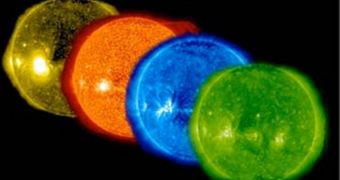When scientists at the US Department of Energy's (DOE) Lawrence Livermore National Laboratory (LLNL) first designed advanced mirrors, they had a specific use in mind, producing better, faster and smaller computer chips. The effort to create these instruments included at one point nearly 200 scientists, as well as experts from three DOE laboratories, and the goal of the investigation was met successfully. But soon, the mirrors proved useful for other applications as well, and now they are being used aboard the recently-launched NASA Solar Dynamics Observatory (SDO), to snap wonderful photos of the Sun, PhysOrg reports.
The telescope captures images of the star once every 10 seconds, with a resolution that is about 10 times more precise than that of high-definition television. All of this would have been impossible without the aid of the advanced mirrors, which were developed at LLNL. The extreme ultraviolet (EUV) multilayer mirrors are now included in one of the three main scientific instruments aboard the SDO, the Atmospheric Imaging Assembly (AIA). Since the entire observatory was constructed to analyze minute variations of the Sun's radiation in EUV wavelengths, one could argue that the mirrors are being used precisely what they were (unknowingly) created for.
But while the technology was indeed developed, putting it on the actual telescope was no small feat. The state-of-the-art reflective multilayer coatings, which were developed by LLNL Physics Division expert Regina Soufli and her team, needed to be deposited on the four telescopes aboard the SDO with a great deal of precision. In fact, the researchers only had the equivalent of one atom's diameter-worth of maneuvering space, and they could not be off by more than that. An additional challenge came when it was time to cover the small spaces that were formed between the layers on the primary and secondary mirrors.
“We had to get the mask close to the mirror surface without touching it, and had to shape the mask edge using a special design, to minimize detrimental ‘shadowing’ effects on the area being coated. This way it enables optimal imaging. Now we will be able to use every photon of the Sun to get the best details and resolution in the images,” says Soufli. The team, which also included experts Eberhard Spiller, Jeff C. Robinson, Sherry Baker and Jay Ayers, managed to optimize the process to the point where the overlapping area of the two layers was reduced to only two millimeters, as opposed to the 20 millimeters it had when work started.

 14 DAY TRIAL //
14 DAY TRIAL //